Help: Single Serial Issue
Eligibility Requirements
A work may be registered as a single serial issue if all of the following conditions have been met:
- The work being registered must be one serial issue.
- A serial issue is a textual work published in successive parts that is intended to be continued indefinitely. Each serial issue bears a numerical (e.g. Volume/Issue number) and/or chronological (e.g. March 5, 2022 or Fall 2021) designation to show that it is part of an ongoing series.
- Examples of common serial publications are magazines; newspapers; academic, professional, and scientific journals; and newsletters.
- The issue must be a collective work.
- A collective work is a type of compilation in which several contributions, constituting separate and independent works in themselves, are assembled into a collective whole. To qualify as a collective work, the single serial issue must include evidence of a sufficiently creative compilation.
- A registration for a collective work covers the copyrightable authorship in the compilation (i.e. selection, coordination, or arrangement) of the individual works that make up the work as a whole.
- A registration for a collective work may also cover the individual works within it if (1) the compilation and the individual works are fully owned by the same party, (2) the individual works have not been previously published or previously registered, and (3) the individual works are not in the public domain.
- For example, a publisher creatively selects, coordinates, and arranges ten articles in their latest magazine issue. The articles are component works; when compiled into one issue, they form a collective work. A registration using the Single Serial Issue application can cover the creative compilation in the collective work and the articles themselves as long as the publisher owns both the compilation and the individual component works, and the component works have not been previously registered, published, or in the public domain.
- On the other hand, a newsletter that only contains one article is NOT a collective work. That work should be registered on the Standard application as a Literary Work.
- The issue must have been published.
- “Publication” is the distribution of a work to the public by sale or other transfer of ownership, or by rental, lease, or lending. Offering to distribute copies of a work to a group of persons for purposes of further distribution, public performance, or public display also constitutes publication. Public performance or display of a work does not constitute publication.
If the issue does not meet all of these requirements, it cannot be registered as a “Single Serial Issue.” Instead, each individual work must be registered on a separate Standard application as a “Literary Work” – one work per application. Learn more.
Under certain conditions, multiple serial issues can be registered together on one application as a group. Learn more about registering a group of serial issues.
Type of Work
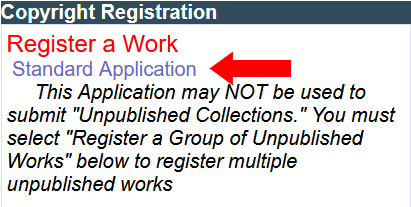
After selecting the Standard Application and clicking on the “Start Registration” button, you will be prompted to identify and confirm the Type of Work you are registering. If your work meets the eligibility requirements described above, select “Single Serial Issue” from the drop-down menu.
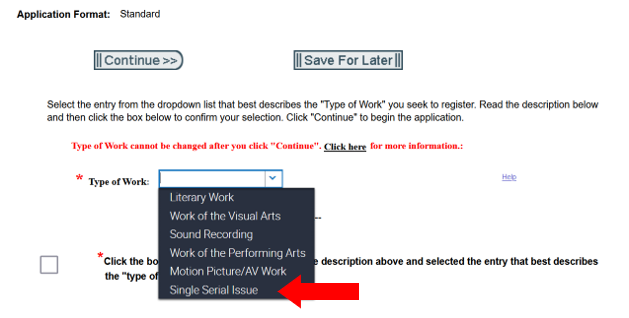
Title(s)
Select the “New” button to add the title of the serial issue.
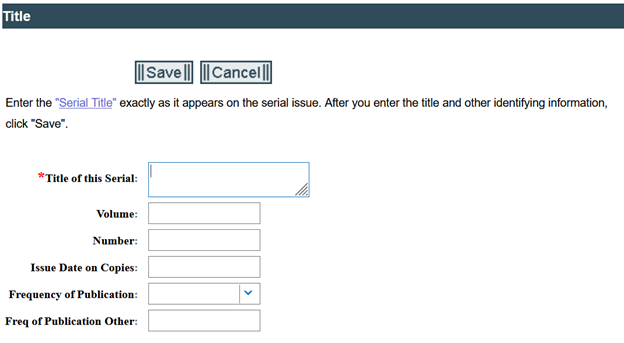
Enter the title exactly as it appears on the copy, and provide any other relevant identifying information about the issue you’re registering, such as the Volume, Number, and/or Issue Date, if applicable.
You may also provide the Frequency of Publication. The Frequency of Publication refers to the regular publication schedule of the serial issue: Is it published weekly, monthly, quarterly, annually, or on a different schedule?
Publication/Completion
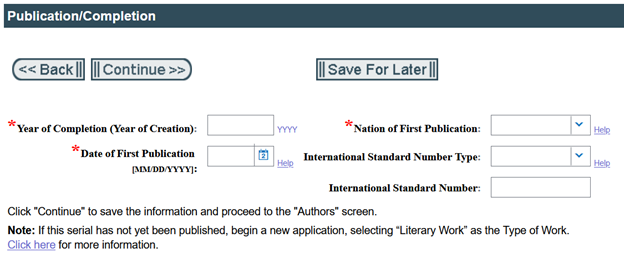
Year of Completion (Year of Creation)
This is the year this particular serial issue was created. The year of completion should not refer to earlier or later versions of this work.
Date of First Publication
Provide the month, day, and year this serial issue was first published in any country. If you do not know the exact date of first publication, give the approximate month, day, and year.
“Publication” is the distribution of a work to the public by sale or other transfer of ownership, or by rental, lease, or lending. Offering to distribute copies of a work to a group of persons for purposes of further distribution, public performance, or public display also constitutes publication. Public performance or display of a work does not of itself constitute publication.
Nation of First Publication
Select the country where this serial issue was first published.
If the work was first published on the same day in the United States and another country, select “United States” as the Nation of First Publication.
If the work was first published in two foreign countries on the same day, you may select either country as the Nation of First Publication.
International Standard Number
If an International Standard Serial Number (ISSN) has been assigned to the publication, you are encouraged to enter it here.
To provide an ISSN, select “ISSN” from the drop down marked “International Standard Number Type” and enter the eight-digit ISSN in the field marked “International Standard Number”.
If you add the publication’s ISSN, it will appear on the certificate of registration and in the online public record for the claim.
Authors
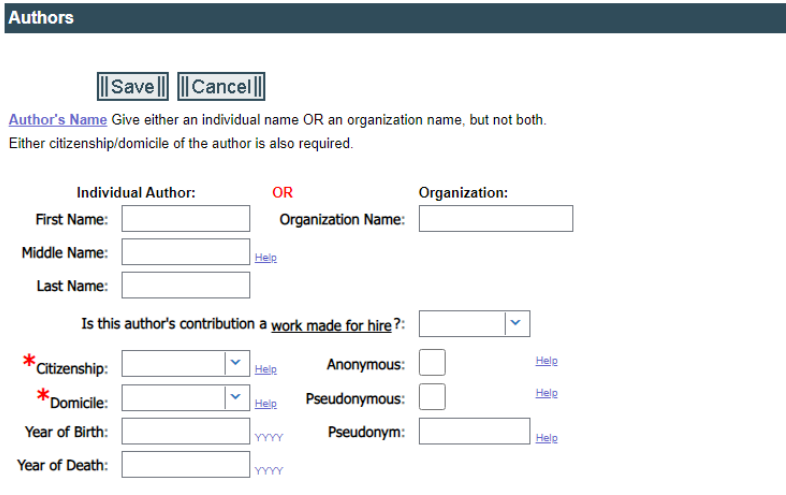
Who is an author of a serial issue?
A serial issue contains two forms of authorship: (i) the individual works and (ii) the compilation of those works. The individual or organization that created the compilation – the selection, coordination, and arrangement of individual works – is the author of the issue.
If the author of the compilation is an individual, provide that person’s first and last name in the spaces under “Individual Author.”
If the author of the compilation is an organization, provide that entity’s name in the space under “Organization.” Any work created by an organization is a “work made for hire;” you must select “Yes” in the work made for hire drop-down menu. For more information on works made for hire see Works Made for Hire (Circular 30).
You should only name the author(s) who created the compilation. Do not provide the name of any contributor who created individual works within the issue unless that contributor also created the compilation. If multiple authors created the compilation, complete the Author(s) screen for the first author, click “Save,” and then add a new author entry for each additional author.
For example, Gardening Monthly LLC compiled 10 articles in their new serial issue. Freelance writers wrote the articles. On the application for the single serial issue, Gardening Monthly LLC (the author of the compilation) should be named as the author; the freelance writers should not be named as authors of the issue. If Gardening Monthly LLC owns the individual articles and wants to include them in the registration, they may do so by providing an appropriate transfer statement on the Claimants screen.
Citizenship/Domicile
How do you determine the author’s citizenship?
“Citizenship” means that the author is a citizen of a particular nation or the author owes permanent allegiance to a particular country, even though he or she is not a citizen of that nation.
How do you determine the author’s domicile?
“Domicile” is the nation where the author has a fixed and permanent residence, where the author intends to maintain his or her residence for an unlimited time, and whenever absent where the author intends to return.
Year of Birth
Providing an individual author's year of birth is optional, but the Office encourages you to include this information, because it may be useful in identifying the individual. If given, the year of birth will appear on the certificate of registration and in the online public record for the claim.
If you are submitting an application for an “anonymous” or “pseudonymous” serial issue, the Office encourages you to provide the author’s year of birth, although it is not required.
If the serial issue is a “work made for hire” do not provide the year of birth.
Year of Death
You should provide a year of death if the serial issue was created by an individual author who is deceased at the time the application is being filed. Copyright law requires this information, because the length of the copyright term may be based on the year that the author died.
If you are submitting an application for an “anonymous” or “pseudonymous” serial issue, the Office encourages you to provide this information, although it is not required.
If the serial issue is a “work made for hire” do not provide the year of death.
Anonymous
Note: This is relatively uncommon for a single serial issue.
What is an anonymous work?
A serial issue is “anonymous” if the individual author who created the work is not identified on the copies of that work. If the author’s name appears on the serial issue, it is not “anonymous,” even if the author does not wish to reveal his or her identity in the registration record. A serial issue created by an organization is not an “anonymous” work.
How should you identify the author of an anonymous work?
If the serial issue was created by an individual author and the author’s name does not appear on the work, check the “Anonymous” box.
You may provide the author’s name in the application, but it is not required. If you wish to provide the author’s name, complete the Individual Author name fields. If you do not wish to provide the author’s name, leave the name fields blank or type “Anonymous” in the First Name field.
If you check the box indicating that the issue was created anonymously — and if you do not want to reveal the author’s identity in the registration record — you should not include the author’s real name anywhere in the application (including the certification screen). If you include the author’s real name in the application it becomes part of the public record and cannot be changed once a registration has issued.
Note: Depending on the circumstances, providing the author’s name in the registration record for an anonymous work may extend or reduce the term of copyright. For additional information see the Compendium of U.S. Copyright Office Practices, chapter 600, section 615.1.
Can an organization be the author of an anonymous work?
An organization cannot be the author of an anonymous work. If the work was created by an organization do not check the box marked “Anonymous.”
Pseudonymous
Note: This is relatively uncommon for a single serial issue.
What is a pseudonymous work?
A single serial issue is “pseudonymous” if the individual author who created the issue is identified on the copies solely by a fictitious name, pen name, or other pseudonym. If both the author’s legal name and fictitious name appear on the issue, the work is not pseudonymous (even if the author’s fictitious name also appears on the issue).
A work created by an organization is not a “pseudonymous” work.
How should you identify the author of a pseudonymous work?
If the serial issue is pseudonymous, check the “Pseudonymous” box and provide the author’s pseudonym in the space provided.
You may provide the author’s legal name in the application, but it is not required. If you wish to provide the author’s legal name complete the Individual Author name fields. If you do not wish to provide the author’s legal name, leave the name fields blank.
If you checked the box indicating that the issue was created pseudonymously — and if you do not want to reveal the author’s identity in the registration record — you should not include the author’s real name anywhere in the application (including the certification screen). If you include the author’s real name in the application it becomes part of the public record and cannot be changed once a registration has issued.
Note: Depending on the circumstances, providing the author’s name in the registration record for a pseudonymous work may extend or reduce the term of copyright. For additional information see Compendium of U.S. Copyright Office Practices, chapter 600, section 615.2.
Can an organization be the author of a pseudonymous work?
An organization cannot be the author of a pseudonymous work. If the work was created by an organization do not check the box marked “Pseudonymous.”
Author Created

The Single Serial Issue application has two “Author Created” options:
Collective Work Authorship
Select this option if the author created the compilation of the serial issue as a whole, but did not create and does not own the individual works (articles, photographs, artwork, etc.) in the issue.
Collective Work Authorship and Component Work(s) authored or fully owned by the Collective Work Author
Select this option if the author created the compilation of the serial issue as a whole, and they created or legally own some or all of the individual works (articles, photographs, artwork, etc.) in the issue. The individual works may be included in the claim unless they have been previously registered, previously published, are in the public domain, or are owned by a third party.
If the copyright in the individual works and the compilation are owned by different parties, or if the individual works have been previously published, previously registered, or are in the public domain, a registration for the serial issue will only cover the compilation; you should select the Collective Work Authorship option. You may register the individual works by submitting a separate Standard “Literary Work” application for each work – one work per application.
If the issue contains some contributions that were previously published alongside some new contributions that are being published for the first time, the registration may cover the compilation and new contributions that the claimant owns. The previously published works may be registered on separate Standard “Literary Work” applications – one work per application.
Claimants
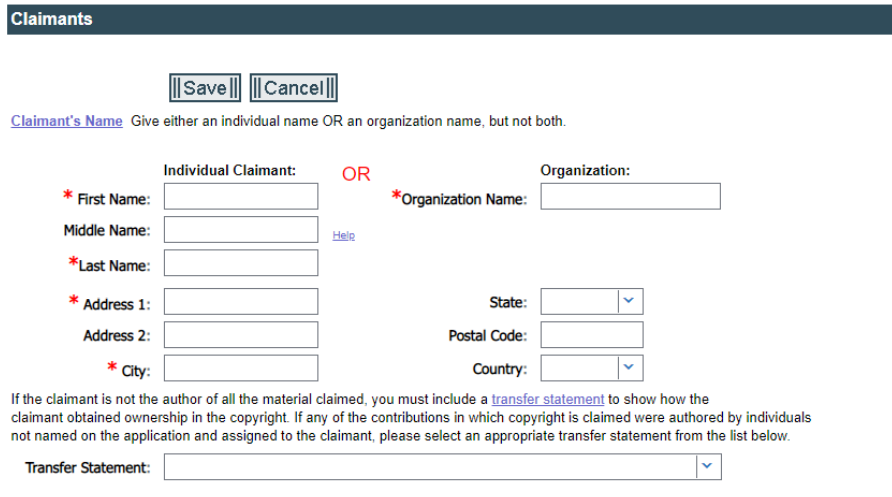
Basic Information
The claimant is the person or entity that owns all exclusive rights in the single serial issue.
The author of the compilation may always be named as a claimant, even if the author transferred rights to another person or entity.
The claimant may also be a person or entity that has obtained ownership of the copyright in the single serial issue. To be named as a claimant, a person or organization must own all rights in the work; ownership of only some of the rights is not sufficient. In addition, a claimant must own the copyright in all of the authorship covered by this registration.
Transfer Statement

If the claimant is not the author of the compilation, a transfer statement is required. Similarly, a transfer statement is required if the claimant intends to register works created by contributors not named on the application.
The transfer statement options on the Single Serial Issue application are:
- By written agreement(s) with author(s) named on the application/certificate
- Select this option if the claimant obtained copyright ownership of the compilation from the compilation author, or if the claimant obtained copyright ownership of both the compilation and some or all of the individual works created by the compilation author.
- By written agreement(s) with individual contributors not named on the application/certificate
- Select this option if the claimant is the author of the compilation and they obtained ownership of the rights in some or all of the individual works from the authors of those works.
- By written agreement(s) with authors named and contributors not named on the application/certificate
- Select this option if the claimant did not create the compilation or the individual works, but they obtained ownership of both the compilation and some or all of the individual works from the compilation author and the authors of the individual works.
Examples:
| Duncan Idaho compiles a monthly bulletin of public domain short stories. Duncan transferred all rights in his December 2021 issue to The Society of Science Fiction Writers in a written agreement. | |
|---|---|
| Author: | Duncan Idaho |
| Author Created: | Collective Work Authorship |
| Claimant: | The Society of Science Fiction Writers |
| Transfer Statement: | By written agreement(s) with author(s) named on the application/certificate |
| Explanation: This registration would cover only the compilation authorship contained in the issue; the individual works are in the public domain. | |
| Fun Science, Inc. publishes a weekly newsletter. They have written agreements with all of their contributors that stipulate that Fun Science, Inc. owns all rights in anything they publish. | |
|---|---|
| Author: | Fun Science, Inc. |
| Author Created: | Collective Work Authorship and Component Work(s) authored or fully owned by the Collective Work Author |
| Claimant: | Fun Science, Inc. |
| Transfer Statement: | By written agreement(s) with individual contributors not named on the application/certificate |
| Explanation: This registration would cover the compilation and any individual works owned by Fun Science, Inc. that have not been previously published. The transfer statement explains how Fun Science, Inc. obtained ownership of the individual works. | |
| Physicians United, LLC compiles and distributes a monthly magazine containing articles on the latest news in medicine. Orizon Corp. owns the entire July 2021 issue through written agreements with Physicians United, LLC and all of the freelance writers who contributed articles to the issue. | |
|---|---|
| Author: | Physicians United, LLC |
| Author Created: | Collective Work Authorship |
| Claimant: | Orizon Corp. |
| Transfer Statement: | By written agreement(s) with authors named and contributors not named on the application/certificate |
| Explanation: This registration would cover the compilation and any individual works owned by Orizon Corp. that have not been previously published. | |
No transfer statement is required if:
- The claimant is the author of the compilation and only intends to register the compilation (“Collective Work Authorship”), or
- The claimant is the author of the compilation and all of the individual works they intend to include in the registration (“Collective Work Authorship and Component Work(s) authored or fully owned by the Collective Work Author”)
Limitation of Claim
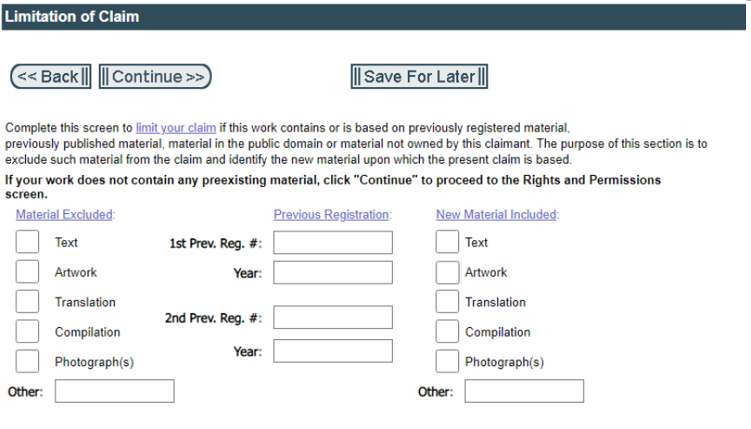
Complete the “Limitation of Claim” section to limit the scope of your copyright claim if the work submitted for registration contains an appreciable amount of unclaimable material, such as:
- material that was previously published,
- material that was previously registered,
- material that is in the public domain, and/or
- material that is owned by any party other than the claimant(s) named in the application
Material Excluded
Check the appropriate box(es) under “Material Excluded” to describe and exclude any unclaimable material contained in the serial issue.
You should exclude:
- material that was previously published,
- material that was previously registered,
- material that is in the public domain, and/or
- material that is owned by any party other than the claimant(s) named in the application
If the terms provided in the checkboxes do not fully describe the material being excluded, you may provide a more specific or detailed description in the field marked “Other.”
Previous Registration
Complete this space if any version of this particular serial issue has been previously registered.
Note: You do not need to complete this space for different issues of the same serial; for example, the application for Volume 2, Number 12 should not provide the previous registration number for Volume 2, Number 11.
If you have received a registration for an earlier or different version of the same issue that you are now trying to register, give the previous registration number and year in the spaces provided. If multiple registrations have been issued, provide the registration number and year for the two most recent registrations. If your application for the earlier or different version of the issue has been submitted but has not yet been processed, state “pending” in the registration number space.
New Material Included
Check the appropriate box(es) under “New Material Included” to describe all of the new material contained in the serial issue that is fully owned by the copyright claimant(s). If the terms provided in the checkboxes do not fully describe the new material that is fully owned by the copyright claimant(s) you may provide a more specific or detailed description in the field marked “Other.”
The descriptions provided in the “New Material Included” field should be consistent with the information provided in the “Author Created” and “Transfer Statement” fields. In other words, any material described in the “New Material Included” section must be mentioned in the “Author Created” section or you must have selected a transfer statement indicating that ownership of some material was transferred by contributors not named on the application.
Examples:
| Jay Ellis is the editor of a monthly magazine titled “Cook’s Digest.” Jay compiled articles and photographs to include in the newest issue, but did not create and does not legally own the articles or photographs. | |
|---|---|
| Author / Claimant: | Jay Ellis |
| Author Created: | Collective Work Authorship |
| Material Included: | Compilation |
| Material Excluded: | Text, Photograph(s) |
| Explanation: This registration would cover the compilation authorship contained in the issue, but not the text or photographs which are owned by other parties. | |
| Dogwood Journal is an annual publication created by For the Trees, LLC. Each annual issue includes some articles written by staff writers, a throw-back article from a previous issue, and new artwork created by a freelancer. The freelancer has not transferred the artwork to For the Trees, LLC. | |
|---|---|
| Author / Claimant: | For the Trees, LLC |
| Author Created: | Collective Work Authorship and Component Work(s) Authored or Fully Owned by the Collective Work Author |
| Material Included: | Compilation, Text |
| Material Excluded: | Text, Artwork |
| Explanation: This registration would cover the new content in the issue that is owned by For the Trees, LLC: the compilation and the new articles written by their staff. The previously published article and artwork are not included in the claim. | |
| Mathematics, Inc. is the author of a weekly magazine. Each article included in the magazine issue is published on Mathematics, Inc.’s website before the print issue is created. The claim must be limited to show that the registration is only for the compilation authorship. The previously published content should be excluded from the claim, but may be registered on separate applications using the appropriate publication date for each article. |
|
|---|---|
| Author: | Mathematics, Inc. |
| Author Created: | Collective Work Authorship |
| Material Included: | Compilation |
| Material Excluded: | Text |
| Explanation: This registration would cover the new compilation. The previously published articles cannot be included in the claim. | |
Deposit Requirements
Issues published in physical copies
Beginning August 22, 2022, if an issue is distributed in physical copies or in both physical and electronic formats, you may submit a digital copy that meets these requirements:
- The entire serial issue must be submitted in one PDF file, and the file size must not exceed 500 MB. (Note: The PDF file may be compressed to meet the file size requirement.)
- The PDF file must be assembled in an orderly manner; it must be viewable and searchable, contain embedded fonts, and be free from any access restrictions that would prevent examination of the issue.
You are encouraged to use one of the Copyright Office’s preferred filename formats:
- If an International Standard Serial Number (ISSN) has been assigned to the serial publication:
[ISSN]_[Date of Publication YYYYMMDD]
Example:
Serial Publication Filename Issue published on November 19, 2021 under ISSN 1234-5678 12345678_20211119.pdf - If an International Standard Serial Number (ISSN) has NOT been assigned to the serial publication:
[Title_of_Serial]_[Date of Publication YYYYMMDD]
Examples:
Serial Publication Filename Issue for publication titled “Fashion Weekly” published on April 15, 2020
No ISSN has been assigned to the publication.Fashion_Weekly_20200415.pdf Issue for publication titled “Copyright Office’s Rules & Regulations” published on January 1, 1998
No ISSN has been assigned to the publication.Copyright_Offices_Rules_and_Regulations_19980101.pdf - If the issue is published with a supplement, use one of the following naming conventions for the file containing the supplement:
- If an International Standard Serial Number (ISSN) has been assigned to the publication:
[ISSN]_[Date of Publication YYYYMMDD]_s - If an International Standard Serial Number (ISSN) has NOT been assigned to the publication:
[Title_of_Serial]_[Date of Publication YYYYMMDD]_s - Examples:
Serial Publication Filename Supplement issue published on November 20, 2021 under ISSN 1234-5678 12345678_20211120_s.pdf Supplement issue for publication titled “Fashion Weekly” published on April 17, 2020
No ISSN has been assigned to the publication.Fashion_Weekly_20200417_s.pdf
Alternatively, you may submit one physical copy of an issue if that issue was only published in physical copies or if the issue was published in physical copies before the electronic version was made available. Follow these steps to submit the physical copy:
- After completing payment, click the “Submit your work” button on the Payment Confirmation screen.
- Click the “Create Shipping Slip” button.
- Click the Shipping Slip attachment link that appears in the Attachments table to open and print the shipping slip.
- Attach the shipping slip to the copy of the serial issue and send the copy (along with the shipping slip) to the address specified on page 1 of the shipping slip.
Note: To avoid misrouting, please be sure to attach a shipping slip directly to the issue. This will ensure that the Copyright Office can connect the issue to the appropriate application. If the shipping slip is not included in the package, the Office will not be able to connect the issue to the appropriate application, which will result in processing delays and possibly a later effective date of registration.
Issues published only electronically
If the issue was published solely in electronic format, you must upload one digital copy containing “all elements constituting the work in its published form, i.e., the complete work as published, including metadata and authorship for which registration is not sought.” See 37 CFR 202.20(b)(2)(iii)(B).